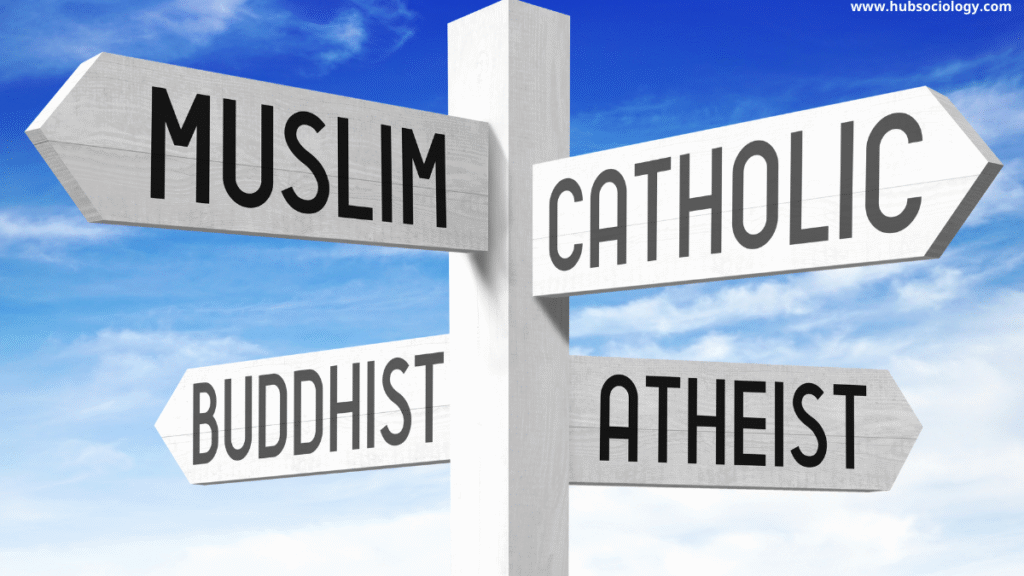Introduction on Clifford Geertz on Contemporary Approaches
Religion has been one of the most significant and complex domains of sociological inquiry. From the classical works of Karl Marx, Émile Durkheim, and Max Weber, religion has been examined through lenses of ideology, social solidarity, and meaning-making. However, in the second half of the 20th century, a new intellectual shift occurred with the emergence of interpretive anthropology, spearheaded by Clifford Geertz (1926–2006). Geertz’s symbolic and interpretive approach to religion has had a profound impact on contemporary sociological and anthropological studies of religion, moving beyond structural or functionalist frameworks toward understanding religion as a system of symbols and meanings.
This article explores Clifford Geertz’s contributions to the study of religion, his definition and methodology, and how his ideas inform contemporary sociological approaches. It also discusses criticisms of his perspective and highlights the continuing relevance of his framework in today’s pluralistic and globalized religious landscape.

Clifford Geertz’s Interpretive Turn
Geertz departed from positivist traditions of social sciences, arguing that human culture and religion could not be studied in purely scientific or mechanical terms. Instead, he emphasized that religion must be understood as a “cultural system”—a network of symbols that provides meaning and coherence to human life.
In his influential essay, Religion as a Cultural System (1966), Geertz defined religion as:
“A system of symbols which acts to establish powerful, pervasive, and long-lasting moods and motivations in men by formulating conceptions of a general order of existence and clothing these conceptions with such an aura of factuality that the moods and motivations seem uniquely realistic.”
This definition reflects several important aspects:
- Symbolic Nature – Religion is not just about doctrines or rituals but about the symbols that communicate meaning.
- Cultural Framework – Religion creates a worldview (how the world is) and ethos (how people should act).
- Experiential Power – Religious symbols shape emotions and motivations by presenting them as “real.”
- Durability – Religion sustains itself by embedding meaning deeply in the lives of its followers.
Religion as a Symbolic System
For Geertz, symbols are central to the study of religion. Unlike Durkheim, who emphasized collective rituals, or Marx, who focused on religion as ideology, Geertz highlighted the interpretive function of symbols. Religious symbols—such as the cross in Christianity, the crescent in Islam, or the wheel of Dharma in Buddhism—are not just decorative; they encode deep cultural values and beliefs.
Geertz argued that symbols operate at two levels:
- Model of reality – They describe the world as it is believed to be.
- Model for reality – They prescribe how humans ought to act in that world.
For example, in Hinduism, the symbol of karma functions both as a cosmological model (explaining cause and effect across lifetimes) and as an ethical guide (encouraging righteous behavior).
Thick Description and the Study of Religion
One of Geertz’s most influential methodological contributions is the idea of “thick description.” Borrowed from philosopher Gilbert Ryle, thick description means going beyond surface-level observation to interpret the cultural meaning of actions.
For instance, observing a group of people bowing in a mosque may appear as a physical act of stretching. But through thick description, one uncovers its religious significance—submission to Allah, collective worship, and the embodiment of humility.
In sociological terms, thick description aligns with qualitative methods, emphasizing participant observation, ethnography, and interpretive analysis over purely statistical or functionalist approaches. This method allows researchers to grasp the inner meaning of religious practices, rather than treating them as mere social facts.

Geertz’s Contribution to Contemporary Approaches
Geertz’s interpretive framework has reshaped how religion is studied in sociology and anthropology, especially in three major ways:
1. Moving Beyond Functionalism
Earlier sociological theories—such as Durkheim’s view of religion as a tool of social solidarity—tended to reduce religion to a social function. Geertz argued that while religion indeed plays functional roles, its primary significance lies in meaning-making. Religion provides frameworks of interpretation, helping individuals cope with existential questions such as suffering, evil, and death.
2. Emphasis on Pluralism and Context
In an increasingly globalized world, religious diversity is a defining feature of social life. Geertz’s approach allows sociologists to study religions within their cultural contexts, avoiding ethnocentrism. For example, instead of evaluating Hindu rituals through a Western rationalist lens, Geertz’s method requires understanding them as meaningful within the Indian cultural and symbolic universe.
3. Bridging Micro and Macro Dimensions
Geertz’s focus on symbols connects individual experience (faith, emotion, identity) with societal structures (traditions, institutions, political authority). This makes his approach especially useful in contemporary studies of how religion influences politics, nationalism, and identity formation.
Critiques of Geertz’s Approach
While Geertz’s symbolic and interpretive approach has been influential, it has also faced criticisms:
- Overemphasis on Meaning – Critics argue that Geertz focused too heavily on symbolic meaning, neglecting material and political aspects of religion. For example, Marxists contend that religion cannot be understood without examining economic and class dynamics.
- Static View of Culture – Geertz sometimes presented religion as a stable symbolic system, overlooking how religions change due to conflict, globalization, or social movements.
- Methodological Limitations – Thick description, while rich in detail, risks subjectivity. The researcher’s interpretation may not always capture the authentic meanings of religious adherents.
Despite these critiques, Geertz’s work remains a cornerstone for qualitative and cultural approaches to the sociology of religion.
Contemporary Relevance of Geertz’s Ideas
In the 21st century, religion continues to be a powerful force shaping identity, politics, and globalization. Geertz’s interpretive approach remains relevant in multiple areas:
- Religion and Globalization – Understanding how religious symbols adapt and transform in diasporic communities.
- Religious Nationalism – Examining how symbols like the cross, crescent, or saffron flag become markers of political identity.
- Interfaith Relations – Using symbolic interpretation to study how different religious traditions engage in dialogue or conflict.
- Digital Religion – Applying Geertz’s framework to study how religious symbols gain new meanings in virtual spaces.
By emphasizing the interpretive dimensions of religion, Geertz’s ideas equip contemporary sociologists to study religion in a world marked by pluralism, migration, and cultural hybridity.
Conclusion on Clifford Geertz on Contemporary Approaches
Clifford Geertz revolutionized the study of religion by shifting the focus from functions and structures to symbols, meaning, and interpretation. His definition of religion as a cultural system and his methodological innovation of thick description continue to inspire sociological inquiry into how religious beliefs and practices shape individual lives and collective identities.

Though not without criticisms, Geertz’s symbolic and interpretive framework remains vital in addressing contemporary questions of religious pluralism, identity politics, and cultural globalization. In a world where religion continues to play a central role in shaping meaning, morality, and power, Geertz’s insights remind us that to understand religion sociologically is not only to analyze its social effects but to interpret its symbolic depth.
Do you like this this Article ? You Can follow as on :-
Facebook – https://www.facebook.com/hubsociology
Whatsapp Channel – https://whatsapp.com/channel/0029Vb6D8vGKWEKpJpu5QP0O
Gmail – hubsociology@gmail.com
Topic-related exam-style questions on Clifford Geertz on Contemporary Approaches
5 Marks Questions on Clifford Geertz on Contemporary Approaches
- Define Clifford Geertz’s concept of religion as a cultural system.
- What is meant by Geertz’s idea of “thick description”?
- Mention two ways in which Geertz’s approach differs from Durkheim’s functionalist view of religion.
- What is the role of symbols in Geertz’s study of religion?
- State one criticism of Geertz’s interpretive approach to religion.
10 Marks Questions on Clifford Geertz on Contemporary Approaches
- Explain the significance of symbols in Clifford Geertz’s understanding of religion.
- Discuss how Geertz’s interpretive approach contributes to the study of religious pluralism.
- How does Clifford Geertz’s concept of religion differ from classical approaches (Marx, Durkheim, Weber)?
- Evaluate the methodological importance of “thick description” in the sociological study of religion.
- Explain the relevance of Clifford Geertz’s approach in understanding religion in the contemporary globalized world.
15 Marks Questions on Clifford Geertz on Contemporary Approaches
- Critically analyze Clifford Geertz’s definition of religion as a cultural system in the context of contemporary sociology.
- Discuss the contributions and limitations of Geertz’s symbolic and interpretive approach to the study of religion.
- How does Geertz bridge micro (individual meaning) and macro (societal structure) aspects of religion in his framework?
- Examine the continuing relevance of Geertz’s ideas for studying religion in contexts of globalization, nationalism, and digital culture.
- “Clifford Geertz shifted the study of religion from structure and function to symbols and meaning.” — Discuss with examples.
